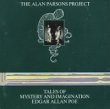
The Alan Parsons Project was the result of a union between producer and sound engineer Alan Parsons and creative director Eric Woolfson. Sharing some interests like horror movies and literature, they tried to create one project, a conceptual opus titled “Tales of mystery and imagination”. This album was to be a musical resemblance of Edgar Allan Poe’s work.
Allan Poe by Alan Parsons
The 70’s were a time for many musical initiatives based on concrete subject matter. Pink Floyd and King Crimson, most notably, made some of the best experiences. “Animals”, “The wall”, “Islands” and “Red” are simply thematic masterpieces. They combine orchestra, synths and acoustic elements with extraordinary results. We’ll talk about them in further reviews.
The Alan Parsons Project didn’t invent anything we didn’t already know, but they added a new dimension: a kind of filmic or stage treatment, and a sound which became their trademark (especially in their instrumental works). The Alan Parsons Project’s music creates clearer images than the albums mentioned before. It’s like a theatrical design of Poe’s universe but avoids the mawkishness of classic musicals. I mean: it’s like a musical but only to be performed individually in each of our minds.
Brilliantly planned, skilled and executed, “Tales” shows Allan Poe’s rich universe from a contemporary viewpoint.
The hypnotic first piece (“A dream within a dream”) is a classic, beginning with a calm dreamlike atmosphere and Orson Welles‘ voice (this voice was added in 1986, ten years after the first release of the album), followed by the obsessive characteristic bass line and the main leitmotiv. It’s enigmatic, mysterious and it sets up the mood for the whole work. By the time it was released, it provided a new dimension in synthesizer music, despite it´s not only using synth music.
Other key moments are reflected in “The raven”, with a great use of the EMI Vocoder (anticipating Moroder, Buggles, etc.), “The tell-tale heart”, the Alan parsons Project’s most awesome rock song, and “To one in Paradise” (one of the more haunting works I’ve ever heard).
Poe was a genius. He would have liked “Tales” because it’s versatile, yet thematically focused; because it´s horror and mystery, yet it´s poetry.
However, the connection between APs continues in The Alan Parsons Project’s discography. There is a subliminal influence, but there are some direct references too. We found “Stereotomy”, whose title track alludes to “The murders in the Rue Morgue”. But I want to finish talking about “The gold bug”, another memorable instrumental work included in “Turn of a friendly card”, based on the homonym Allan Poe’s tale.
It’s only an opinion, but I think that the best way to enjoy “Tales” or any of Poe’s inspiring stories is to combine both of them. And don’t forget “The gold bug”.